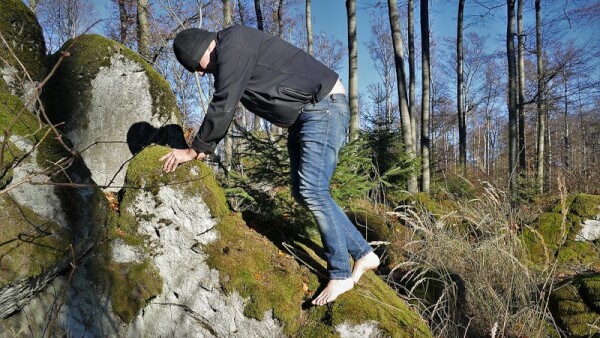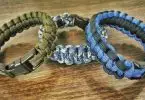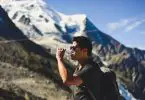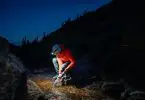Barefoot hiking is more than what people might think on first glance. Yes, it does literally entail hiking without shoes or socks on, but doing so promotes a whole new way of interacting with the natural world.
You can’t hike barefoot and not notice the way the cool, dewy grass feels on the soles of your feet. It would be impossible to just hike, unaware of mud or silt squishing up between your toes.
See also: Benefits of Hiking: How to Make the Hiking Trip Improve Your Health
The sensations you feel on your feet, with their 2,000 nerve endings apiece, are said to heighten all your other senses on the trail. That’s just one of many benefits touted by barefoot enthusiasts!
The deep interaction with nature promoted by barefoot hiking harks back to the days when Chinese reflexology medicine was new on the scene (in about the 2nd century B.C.). Practitioners claimed that by stimulating different parts of your feet, you could stimulate (and benefit) other areas of the body that were ailing.
Reflexology is still practiced all over the world, and can sometimes incorporate walking barefoot across stone paths for specific stimulation. Later on, in the 19th century, a Belgian named Sebastian Kneipp developed his own form of naturopathic medicine. This involved using natural stimuli as therapy for a variety of internal illnesses, and some of his treatments included walking unshod through wet grass or into a shallow pool.
Today, hiking barefoot is a (usually) low-key activity that allows folks from all ages and ability levels to exercise and heal in an extremely natural way. Walking barefoot through the forest or along a stream not only strengthens muscles in the feet and tones new muscles in the legs, but can relieve stress on the low back and other joints as well.
Because your feet are more flexible in their natural state than in shoes or hiking boots, you may find that you have more traction on slippery surfaces; you can use your toes to grip the earth in a unique way. Barefoot exploring is just one of many outdoor activities you can do while barefoot – barefoot running has also gained immense popularity in recent years.
Why is it so popular?
Aside from healing properties, going barefoot for running and hiking has grown in popularity in the past two decades for other reasons. Many runners found themselves experiencing chronic foot injuries while training for races, and saw that once they started training barefoot, these injuries went away. These revelations have also led to the development of shoe middlemen (or middleshoes, if you will) such as Vibram or Merrell imitation-barefoot shoes.
It has also continued to be a way for people to deeply connect with nature. Two women, Lucy and Susan Letcher, hiked the majority of the Appalachian Trail barefoot back in 2000.
Check out: How to Hike the Appalachian Trail: Your Guide to the World’s Longest Thru-Hike!
They started out tender-footed, but a few weeks in, had toughened up the soles of their feet enough where they weren’t so much as worrying about what they were stepping on as enjoying it. Apparently, there was one point where they’d been stepping on glass shards and didn’t even realize it.
Additionally, two guys put out books on the subject. Christopher McDougall wrote “Born to Run,” and Richard Frazine authored “The Barefoot Hiker,” both of which discuss the benefits of shedding your shoes and running and hiking barefoot.
While McDougall’s book takes more of a historical and interview-and-analysis approach on being unshod, Frazine’s is a bit more autobiographical (though McDougall’s work touches on his personal journey from a couch potato to a long-distance runner) and discusses hiking specifically.
If you’re someone like me who likes to be quite well-informed before delving into a new habit, I suggest picking one (or both) of these up. In any case, their works helped to foment the movement of being barefoot in the outdoors even more.
The craze caught on as fitness buffs and nature lovers alike realized what a better experience they were having hitting the trail without shoes. More research has been done recently about the athletic shoe industry, how arch supports actually can lead to arch collapse later in life (due to not having built up the muscles properly), and how hiking barefoot has a much softer impact on trails than hiking in heavy boots.
Those initial barefoot trail blazers (along with the fact that up until about 40,000 years ago everyone was walking around barefoot) have since inspired more and more people to shed the boots and shoes and go au natural. There are now Facebook and MeetUp groups in the majority of states in the US, and in several European countries where the lifestyle is more popular (it’s really big in Germany).
How can you get ready for a barefoot hike?
Since hiking no barefeet is fairly accessible to able-bodied folks, preparation is simple – though it will take some time, depending on your history with being barefoot. Simple, because there aren’t multiple steps to go through and gear to buy, but time-intensive because like anything else physical, your body needs time to adapt.
As you use different muscles to support your gait during a barefoot hike, muscle soreness is common amongst beginners. People have noted that those new to the unshod lifestyle can feel like a sudden blackout – it’s a sensory overload and feels overwhelming at first, but eventually, your body adjusts and you can navigate normally.
Steps to Preparation
Walk around barefoot for a few minutes
Experts recommend to start slow, in a familiar place. If you have a backyard, give it a whirl there – take note of the different textures, and take deep breaths. Go slowly, be patient with yourself, but encouraging too. Try to do it for at least 10 minutes. You can always throw in the towel, and wash your feet when you’ve had enough after that.
Slowly expand your barefoot radius
Once you’ve gotten comfortable spending extended periods of time in your backyard, start expanding the places where you go barefoot. Think about taking your talents to the streets and parks nearby. Bring shoes with you, just in case, and be aware of the ground surfaces around you.
Don’t worry – there will be a time where you will be able to anticipate what different textures will feel like, where there might be debris you want to avoid stepping on, etc.
Scope out trails near you
Look for ones that have smoother surfaces or short gravel lead-ins (as little gravel as possible is ideal for beginners), and see if you can get a supportive friend to tag along. Stay aware of the ground in front of you, take mindful, deliberate, toe-to-heel steps, and try placing the majority of your weight on the balls of your feet. As this is the widest part of your foot, it is best equipped to support your body weight.
If you live in Europe, check to see if there are dedicated barefoot parks near you! These are specially curated parks with a plethora of textures for your feet to get to know, and they will usually be better maintained in terms of litter picked up, etc., than regular parks.
Bring supplies
A key thing to remember is that while yes, you are trying to train your feet and your body to get used to something new, you don’t have to go at anyone else’s pace but your own. Bringing along water, band-aids, tweezers, and spare shoes and socks. You can stop any time to rest, to put your shoes back on, to rinse off your feet with water, whatever you need!
Bringing spare shoes, whether they’re full-fledged hiking boots or minimalist Merrells, is a good idea no matter if you’re a beginner or advanced dirtbag hiker. Coming across well-worn pieces of trail is inevitable nowadays. For the best first aid kit you can take camping, see our article on this topic.
If you’re making camp along the way too, or stopping by a trail shelter, know that these areas can be littered with debris, and it’s much better to be safe than sorry. Throw on your shoes when you get to these places so you can continue with the rest of your journey safely, and barefoot, as you intended.
Join a local group
Once you’re comfortable going out barefoot on the trail on your own, something that can make the experience more enjoyable is making it social. A simple google search, along with searches on social media outlets, will yield contact information for local groups who go out for hikes.
The best part of these groups is that they’re low stress and friendly. Hiking sans footwear, while yes, being great for exercise, are really open to sharing the lifestyle with newcomers, and don’t push people (too far) out of their comfort zone. All they ask is that you accept their way of life!
Go!
And, remember that no one is forcing you to do this. This is something that you want to do, something that you want to experience. Go at your own pace, with people or solo, and enjoy the feeling of your feet muscles toning up, being more in-tune with the nature all around you, and whyever else you decided to do this. It’s your journey!
In Conclusion
Going barefoot can tend to have a negative connotation, sometimes being associated with poverty or childish foolishness. People like McDougall, in Born To Run, try to expand audience’s horizons by discussing topics from the amazing endurance of Tarahumara Indians in Mexico who run super long distances barefoot/in minimalist shoes to the athletic shoe industry and how our bodies are, well, naturally born to run (without shoes).
Companies like TOMS host A Day Without Shoes every April, encouraging people to shed their footwear. Spa treatments today still include those ancient Chinese and Belgian practices of walking barefoot on various surfaces, stimulating the feet to stimulate other areas of the body.
Engaging in barefeet hiking is something you can do if you want the benefits of sensory stimulation without paying the spa price tag, or if you’re just looking for a new way to get back to nature.
It cannot be overstated how every single person that’s gone barefoot hiking and then has been interviewed has gushed over how much more in touch with nature and with their bodily senses they felt. It can be like waking up a whole new side of yourself. With a little preparation of your feet and of your mind, you’ll be on barefoot hikes along the trail in no time. Also check out our guide on how to treat blisters when you’re out camping.
Featured Image Source: https://www.flickr.com/photos/149556095@N03/46274034475








